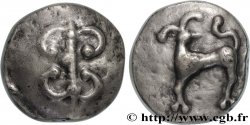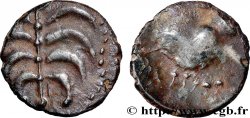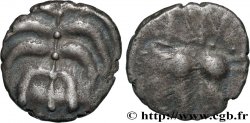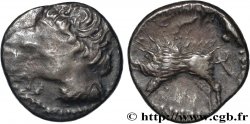v28_0685 - HELVETI (Current Switzerland) Statère de Philippe II, imitation celtique type de “Montmorot”
MONNAIES 28 (2007)
起拍价 : 1 800.00 €
估价 : 2 800.00 €
竞价记录 : 1 800.00 €
出价数量 : 1
最高出价 : 1 960.00 €
起拍价 : 1 800.00 €
估价 : 2 800.00 €
竞价记录 : 1 800.00 €
出价数量 : 1
最高出价 : 1 960.00 €
种类 Statère de Philippe II, imitation celtique type de “Montmorot”
日期: IIe-Ier siècles avant J.-C.
材质 gold
直径 19 mm
模子方针 11 h.
重量 8,32 g.
稀少度 R3
关于品相的说明
Statère centré sur un flan large et lourd. Le droit est de frappe molle et/ou frappé avec un coin usé. Le revers est légèrement décentré sur la droite. Un petit coup sur la tranche est à signaler, à 10 heures au revers
出版目录中的项代码 :
家谱
Ce statère proviendrait d’une collection familiale vendéenne
正面
正面的文字 ANÉPIGRAPHE.
正面的说明书 Tête laurée à droite, imitant la tête d’Apollon.
背面
背面的说明书 Bige galopant à droite, les chevaux bondissant, avec un objet indéterminé sous les pattes avant ; l'aurige, au-dessus de la roue du char, tient un fouet ; traces de légende, mais pas de ligne d'exergue, avec un poisson (?) dessous.
背面铭文 fILIPP.U.
评论
Ce statère est une dégénérescence du type d'Abydos, avec l'épi de blé en différent au revers. L'attribution aux Helvètes est possible, mais pas certaine, pas plus que celle aux Arvernes ou bien encore une hypothétique attribution aux Carnutes. La concentration des trouvailles, pourtant dispersées, serait plutôt dans l'est de la France. Mais peut-on considérer qu'un seul peuple en est à l'origine....








 对产品描述纠错
对产品描述纠错 打印
打印 分享我的选择
分享我的选择 提问
提问 Consign / sell
Consign / sell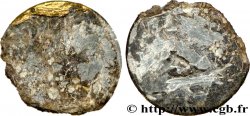
 产品介绍
产品介绍